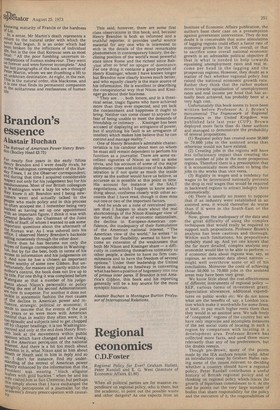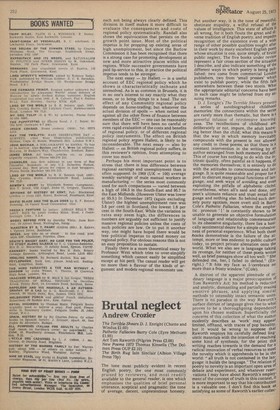Regional economics
C.D.Foster
Regional Policy for Ever? Graham Hallett, Peter Randall and E. G. West (Institute of Economic Affairs, £1.80)
When all political parties are for massive expenditure on regional policy, who is there, but the academic, to point out the possible waste and other dangers? As one expects from an Institute of Economic Affairs publication, the authors base their case on a presumption against government intervention. They do not doubt it is conceivable that some stimulation of lagging regions could effect a faster rate of economic growth for the UK overall, or that to sacrifice some overall national economic growth is an admissible political objective if that is what is needed to help towards equalising unemployment rates and real income per head in the lagging and the prosperous regions. However, they doubt as a matter of fact .whether regional policy has raised the national economic growth rate. Rather they think that the rather modest move towards equalisation of unemployment rates and real income per head that has actually been achieved, has probably been at a very high cost.
Unfortunately this book seems to have been written before Professor A. J. Brown's monumental The Framework of Regional Economics in the United Kingdom was published late last year (CUP). Brown deployed more facts than do these authors and managed to demonstrate the probability of several propositions.
(I) Regional policy has created some 50,000 to 70,000 jobs in the assisted areas that otherwise would not have existed.
(2) Creating jobs in the regions will have less inflationary impact than creating the same number of jobs in the more prosperous regions. Therefore there is a presumption that it is economically more efficient to bring the jobs to the works than vice versa.
(3) Rigidity in wages and a tendency for wages to be determined nationally prevents the drop in real wages that would be required in backward regions to attract ind4try there automatically.
(4) There is usually no reason to suppose that if an industry were established in an assisted area, it would thereafter do worse than if it were in the South-East or the Midlands.
Now, given the inadequacy of the data and the great difficulty of using the complex techniques that would really be required to support such propositions, Professor Brown's analysis has been cautious and thorough. Within such limitations, his propositions probably stand up. And Yet one knows that the far more detailed, complex analysis any economist would like to be able to perform — if economic data about regions was, say, as copious, as economic data about nations — might well overthrow some or all of his conclusions. Moreover the costs of achieving those 50,000 to 70,000 jobs in the assisted areas may have been very great.
We know little about the cost-effectiveness of different instruments of regional policy — REP, various forms of investment grant, depreciation allowances, additional expenditures on public works etc. We do not know what are the benefits of, say, a London location which make it worthwhile for some firms, at least, to pay much higher rents there than they would in an assisted area. We talk freely of ' congested ' regions of the country but we have only imprecise and incomplete measures of the net social costs of locating in such a region by comparison with locating in a development area. Professor Brown has collected more facts, and used them more relevantly than any of his predecessors, but the doubts remain.
Though pre-Brown, many of the points made by the 1EA authors remain valid. After an introductory essay by Graham Hallet raising some of the issues relevant to deciding whether a country should have a regional policy, Peter Randall contributes a useful history of British regional policy and of thinking on regional policy which traces the growth of bipartisan commitment to it. At the end he points out the very large number of bodies that share responsibility for the policy and the execution of it, the responsibilities of
each not being always clearly defined. This division in itself makes it more difficult to evaluate the consequences and costs of regional policy systematically. Randall also shows the equivocation that persists on the growth point issue. Most of the political impetus is for propping up existing areas of high unemployment, but since the Barlow Commission it has been recognised that there is a strong case for promoting development at new and more attractive places within old regions. While successive governments have paid lip-service to this, in practice the political impetus tends to be stronger.
The next essay —.by Hallett — is a useful account of EEC regional policy which he shows is characteristically inchoate and unresolved. As is so common in Brussels, it is in no one's interest to say exactly what they mean, or to bring things to a head. The net effect of any Community regional policy depends on horse-trading; but whatever the actual division of spoils — when netted out against all the other flows of finance between members of the EEC — one can be reasonably sure that there will have been no careful or even rapid evaluation of the costs and benefits of regional policy, or of different regional policy instruments. The effect on British regional policy argues Hallett, is likely to be inconsiderable. The next essay — also by Hallett — on British regional policy suffers, in this reviewer's opinion, from attempting to cover too much.
Perhaps his most important point is to stress that there is less difference between regional earnings and unemployment than is often supposed. In 1969 (UK -100) average weekly earnings of male manual workers in manufacturing' — the series most commonly used for such comparisons — varied between a high of 104.5 in the South-East and 95.7 in the East Midlands. (However Ulster was lower at 95.9.) In December 1972 (again excluding Ulster) the highest unemployment rate was 5.8 per cent in Scotland, the lowest 1.8 per cent in the South-East. While the variation in rates may seem high, the differences in numbers are arguably not sufficient to justify massive regional policies unless the costs of such policies are low. Or to put it another way, one might have hoped there would be less political impetus to spend money on regional policy. For obvious reasons this is not an easy proposition to sustain.
Finally there is a more theoretical essay by Professor West which tries to over-simplify something which cannot easily be simplified except at his peril. The casual reader will get no more than a flavour of the kinds of argument and models regional economists use.



































 Previous page
Previous page